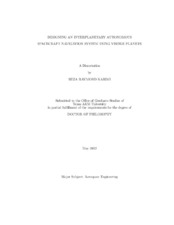| dc.contributor.advisor | Mortari, Daniele | |
| dc.creator | Karimi, Reza | |
| dc.date.accessioned | 2012-07-16T15:58:31Z | |
| dc.date.accessioned | 2012-07-16T20:31:26Z | |
| dc.date.available | 2014-09-16T07:28:21Z | |
| dc.date.created | 2012-05 | |
| dc.date.issued | 2012-07-16 | |
| dc.date.submitted | May 2012 | |
| dc.identifier.uri | https://hdl.handle.net/1969.1/ETD-TAMU-2012-05-11084 | |
| dc.description.abstract | A perfect duality exists between the problem of space-based orbit determination from line-of-sight measurements and the problem of designing an interplanetary autonomous navigation system. Mathematically, these two problems are equivalent. Any method solving the first problem can be used to solve the second one and, vice versa. While the first problem estimates the observed unknown object orbit using the known observer orbit, the second problem does exactly the opposite (e.g. the spacecraft observes a known visible planet). However, in an interplanetary navigation problem, in addition to the measurement noise, the following "perturbations" must be considered: 1) light-time effect due to the finite speed of light and large distances between the observer and planets, and 2) light aberration including special relativistic effect. These two effects require corrections of the initial orbit estimation problems. Because of the duality problem of space-based orbit determination, several new techniques of angles-only Initial Orbit Determination (IOD) are here developed which are capable of using multiple observations and provide higher orbit estimation accuracy and also they are not suffering from some of the limitations associated with the classical and some newly developed methods of initial orbit determination. Using multiple observations make these techniques suitable for the coplanar orbit determination problems which are the case for the spacecraft navigation using visible planets as the solar system planets are all almost coplanar. Four new IOD techniques were developed and Laplace method was modified. For the autonomous navigation purpose, Extended Kalman Filter (EKF) is employed. The output of the IOD algorithm is then used as the initial condition to extended Kalman filter. The two "perturbations" caused by light-time effect and stellar aberration including special relativistic effect also need to be taken into consideration and corrections should be implemented into the extended Kalman filter scheme for the autonomous spacecraft navigation problem. | en |
| dc.format.mimetype | application/pdf | |
| dc.language.iso | en_US | |
| dc.subject | Initial Orbit Determination | en |
| dc.subject | Spacecraft Navigation | en |
| dc.subject | Extended Kalman Filter | en |
| dc.subject | Light-time correction | en |
| dc.subject | light Aberration | en |
| dc.title | Designing An Interplanetary Autonomous Spacecraft Navigation System Using Visible Planets | en |
| dc.type | Thesis | en |
| thesis.degree.department | Aerospace Engineering | en |
| thesis.degree.discipline | Aerospace Engineering | en |
| thesis.degree.grantor | Texas A&M University | en |
| thesis.degree.name | Doctor of Philosophy | en |
| thesis.degree.level | Doctoral | en |
| dc.contributor.committeeMember | Junkins, John L. | |
| dc.contributor.committeeMember | Vadali, Srinivas R. | |
| dc.contributor.committeeMember | Hurtado, Johnny E. | |
| dc.contributor.committeeMember | Bhattacharyya, Shankar | |
| dc.type.genre | thesis | en |
| dc.type.material | text | en |
| local.embargo.terms | 2014-07-16 | |


